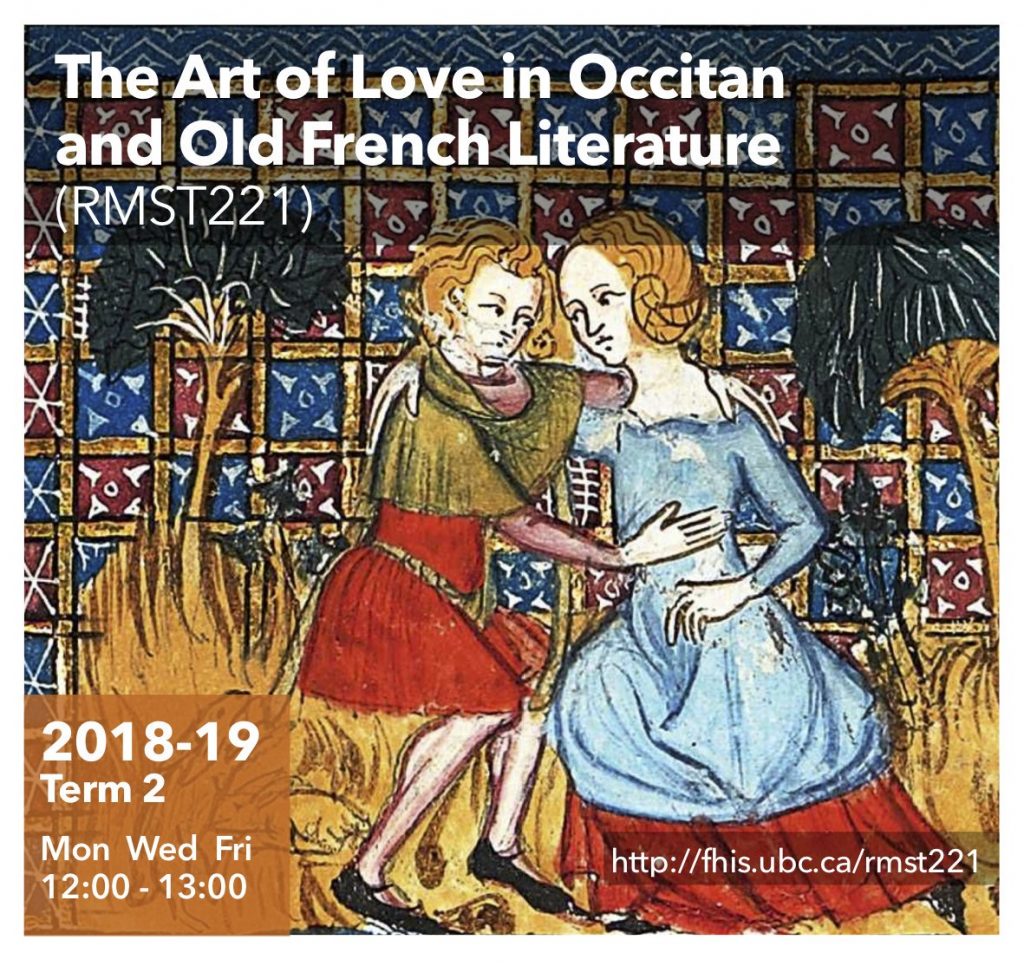Dr Patrick Moran
UBC Department of French, Hispanic & Italian Studies
Term 2
Monday, Wednesday, & Friday 12:00 noon – 1:00 p.m.
 In the 12th century, Western Europe became passionate about love. Fine amor, or courtly love, was born in the Occitan regions with the songs of the troubadours. It migrated to the North of France and Langue d’oïl, where it gave birth to specific genres of narrative literature (lais and romances), before spreading throughout Western Europe under various guises. Courtoisie is both an aesthetic system and an ideology. It puts love and sensual desire at the top of its hierarchy of values, thus redefining and challenging several social and moral conventions – especially the sanctity of marriage. The aim of this course is to study this important cultural phenomenon across different spheres of the Romance world, beginning with troubadour poetry in Langue d’oc. We will then shift to courtly narratives in Langue d’oïl, specifically the legend of Tristan and Iseut (which depicts major courtly topics such as adultery, amour de loin and erotic longing), but also the courtly lais of Marie de France. The study of the Roman de la Rose by Guillaume de Lorris and the latin De amore by André le Chaplain (Andreas Capellanus) will help us understand how clerical authors reinterpret courtly love at the dawn of the 13th century.
In the 12th century, Western Europe became passionate about love. Fine amor, or courtly love, was born in the Occitan regions with the songs of the troubadours. It migrated to the North of France and Langue d’oïl, where it gave birth to specific genres of narrative literature (lais and romances), before spreading throughout Western Europe under various guises. Courtoisie is both an aesthetic system and an ideology. It puts love and sensual desire at the top of its hierarchy of values, thus redefining and challenging several social and moral conventions – especially the sanctity of marriage. The aim of this course is to study this important cultural phenomenon across different spheres of the Romance world, beginning with troubadour poetry in Langue d’oc. We will then shift to courtly narratives in Langue d’oïl, specifically the legend of Tristan and Iseut (which depicts major courtly topics such as adultery, amour de loin and erotic longing), but also the courtly lais of Marie de France. The study of the Roman de la Rose by Guillaume de Lorris and the latin De amore by André le Chaplain (Andreas Capellanus) will help us understand how clerical authors reinterpret courtly love at the dawn of the 13th century.
Required Texts
Gottfried von Strassburg, Tristan, with the ‘Tristran’ of Thomas (Penguin Classics, 1960)
The Lais of Marie de France (Penguin Classics, 1999)
The Romance of the Rose (Oxford World’s Classics, 2009)
Recommended Reading
Proensa: an Anthology of Troubadour Poetry (U. of California Press, 1978)
Andreas Capellanus, On Love (Duckworth, 1982)
Prerequisite: None
Language of instruction: English
(For other iterations of this course taught by Dr O’Brien, please update your links:
RMST 221 (2009) – “Adventures”
RMST 221 (2010) – “Mischief”
RMST 221 (2011) – “Intrigue”
RMST 221B (2019) – “Animal Reading”)
